Note: This trip was before the coronavirus pandemic – I’m (slowly!) updating this blog with posts about my travels since I started working remotely and backpacking. I hope to get up to date and start blogging about my temporary home, Taiwan, in a couple of months’ time.
Despite encountering various difficulties trying to work remotely in Sri Lanka, I had a great time exploring the country. Sri Lanka has so much to offer – endless greenery, mountains to hike, beaches to relax at, ancient ruins to explore, safaris, amazing food and possibly the best train rides in the world.
I spent a month in Sri Lanka and this three week itinerary is based on that. Sri Lanka has far more to offer than can be seen in this timeframe, but the route goes around many of the highlights, including seven of the country’s eight UNESCO World Heritage sites. This is purely based on a visit for leisure – I wouldn’t be able to do this itinerary in three weeks as I work remotely while travelling. If you plan to work remotely while in Sri Lanka, add extra time as needed to this itinerary and check out my post on the ‘joys’ I had working online here.
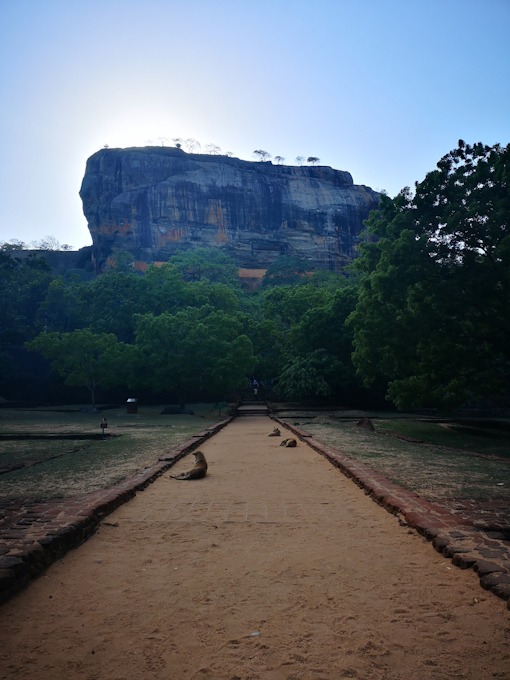
Getting to Sri Lanka
The international airport is actually in Negombo, a city near Colombo, Sri Lanka’s capital. It is approximately 30 kilometres north of Colombo. You can travel between the two by either train, bus, taxi or tuk-tuk. Trains are the cheapest but they are infrequent and you need to take a tuk-tuk from the airport to Negombo Railway Station first. Taxis and tuk-tuk’s are the most convenient and expensive method of travel from the airport to Colombo. Taking the bus, which should take about one hour, is the middle option between time and cost. It was late when I arrived so I opted for the convenience of a tuk-tuk booked through Uber. When you get to the arrival lounge, you’ll probably be approached by a tout who will quote a high price and claim Uber won’t come to the airport – this is a lie so ignore them and carry on.
Getting around Sri Lanka
There are three main ways to get around Sri Lanka:
Trains – the train network is not comprehensive and the trains are slow, not particularly comfortable and somewhat unreliable, but you absolutely have to experience at least one train ride here. What they lack in luxury, they more than make up for in the views. The train rides between Kandy and Ella were incredible and one of the highlights of my trip. The doors in each carriage are open the whole time so you can sit in the door and watch as you pass seemingly never ending green landscapes. Just be careful hanging out those doors!
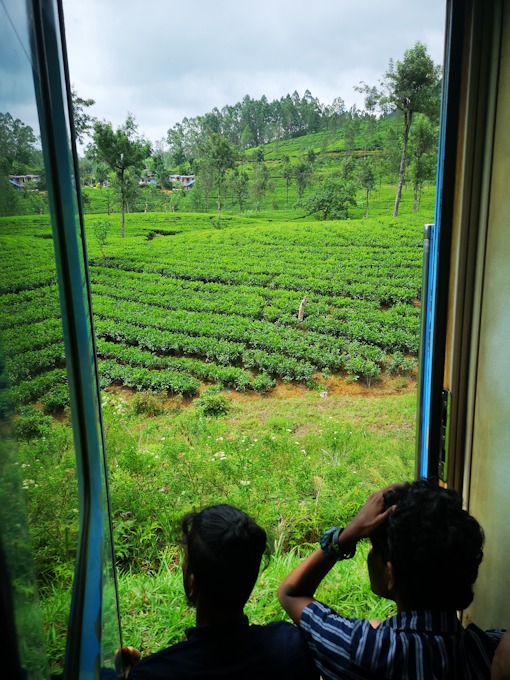
Buses – when trains aren’t an option, buses are another cheap way to get around the country. Just be warned that the bus drivers in Sri Lanka all seemed to be on another level of crazy to anywhere else I’ve visited and spend most of the time driving on the wrong side of the road, blaring their horns at everything else to get out of the way. At least they’re fast!
Tuk-tuks – also a fun way to get around, but more expensive. There are many tuk-tuk drivers in any popular tourist spot in Sri Lanka, ready to quote ridiculous fees (don’t accept them, haggle hard!) to take you anywhere. Tuk-tuks are available for short rides, day trips and long distance journeys. To avoid the aggravation of haggling, Uber is available (only in Colombo unfortunately) for both tuk-tuks and regular taxis. There is also a Sri Lankan app called PickMe which, in addition to the Colombo area, also operates in Kandy. As an alternative, you can actually hire a tuk-tuk and self-drive it around Sri Lanka. I met a few people around the country who were doing this and they were enjoying it. For a guide on driving a tuk-tuk around Sri Lanka, this is an informative read.
My 3 Week Sri Lanka Itinerary
DAYS 1-2 (one night)| ARRIVE IN COLOMBO, SEE THINGS, LEAVE
Day 1: Arrival
Day 2: Sightseeing then train to Anuradhapura
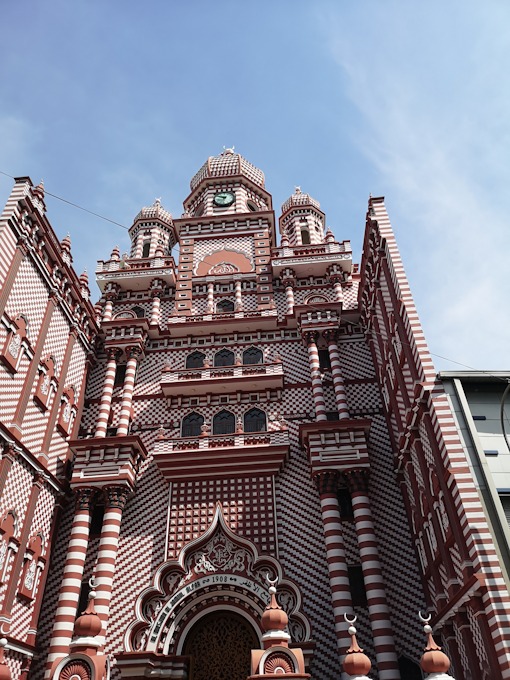
The start and end point of the trip, Colombo is, in my opinion, one of the worst capital cities I have visited. Big, chaotic and with very few appealing things to see and do. To be fair, my experience of Colombo is based on just a few days there and a city is always going to have more to offer than a visitor can see in such a short time (especially since I was working for most of the time I stayed in Colombo). I came across this blog post, by somebody who was living there, which gives various ideas on things to do in the city but, unless you have unlimited time in Sri Lanka, I’d suggest leaving Colombo pronto. Stay one night to relax after the flight and allow time the next day for some sightseeing, then get out of there!
DAYS 2-4 (two nights)| ANURADHAPURA & MIHINTALE
Day 2: Arrive from Colombo
Day 3: Sightseeing in Anuradhapura and Mihintale
Day 4: Morning bus to Sigiriya (changing at Dambulla)
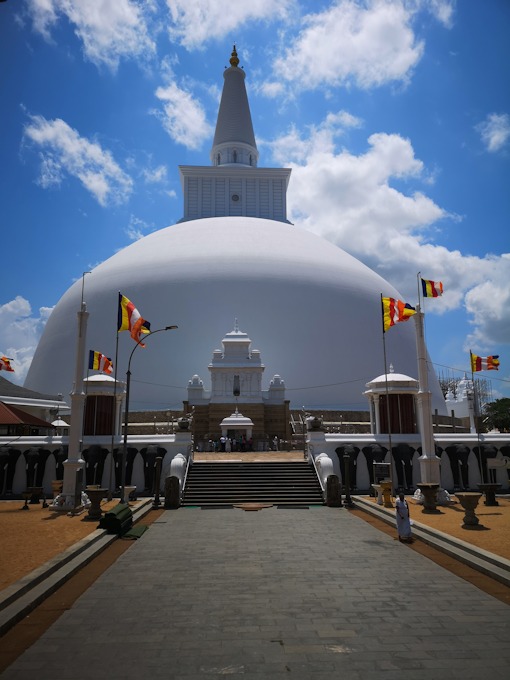
From Colombo Fort Station, take a train to Anuradhapura (about four hours) and have a relaxed evening. Depending on where you’re staying, you may want to get off the train at Anuradhapura New Town, one stop before Anuradhapura Station.
Anuradhapura is a sacred city and reportedly where the Buddha attained enlightenment. The main thing to do here is to explore the archaeological ruins and religious sites. The nearby mountain peak of Mihintale, approximately a 16km drive from Anuradhapura, attracts visitors for the same reason.
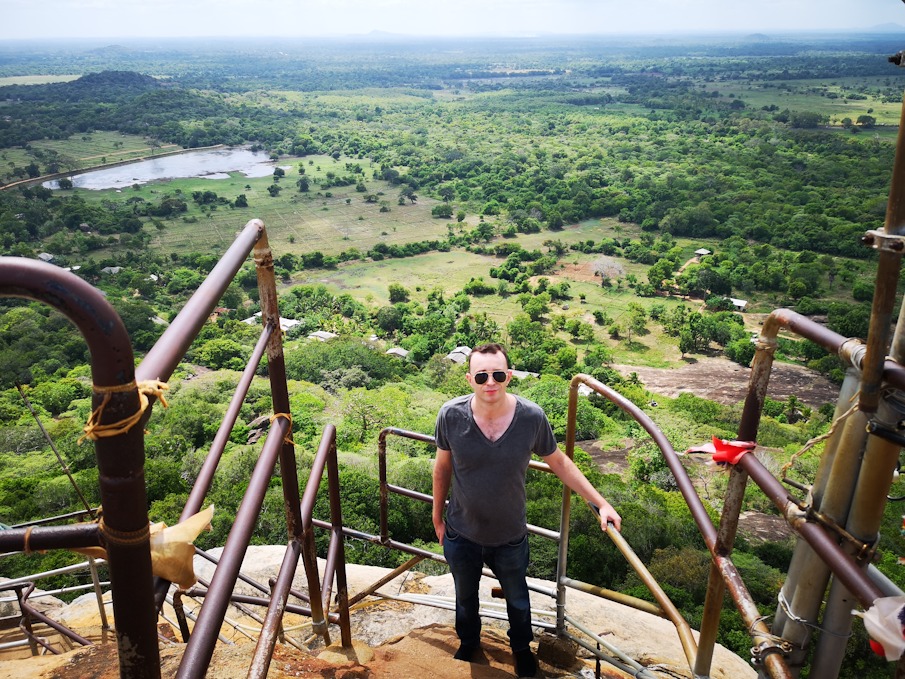
On my first night in Anuradhapura, I arranged a tour for the following day with the owner of the guesthouse covering Anuradhapura and Mihintale. I was the only person staying at the guesthouse at the time so the owner offered to give me the tour on his motorbike, rather than the standard option of organising a tuk-tuk driver for the day. You can also rent a bicycle in Anuradhapura and go around alone but, including Mihintale, this would make for a long day. He didn’t set a price and suggested a tuk-tuk tour would typically cost around 4,000 LKR. After the tour I decided to pay 5,000 LKR, since his business was struggling following the terrorist attacks in April 2019 and he seemed like a decent person.
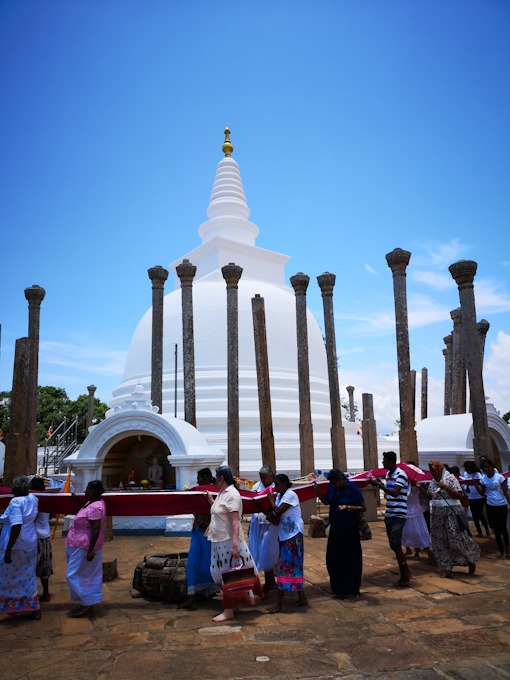
For the tour itself, I was taken around numerous ancient sites. The size of some of the stupas was impressive and it was interesting to observe religious ceremonies that were in progress at a couple of the sites, but the highlight was Mihintale. Mihintale is believed to be one of the earliest sites for Buddhism in Sri Lanka and many locals visit to make the short hike up to the top of Mihintale Peak. Everyone here seemed to be very happy and enjoying themselves, including the owner of the guesthouse I was staying at, who told me he had never been here before.
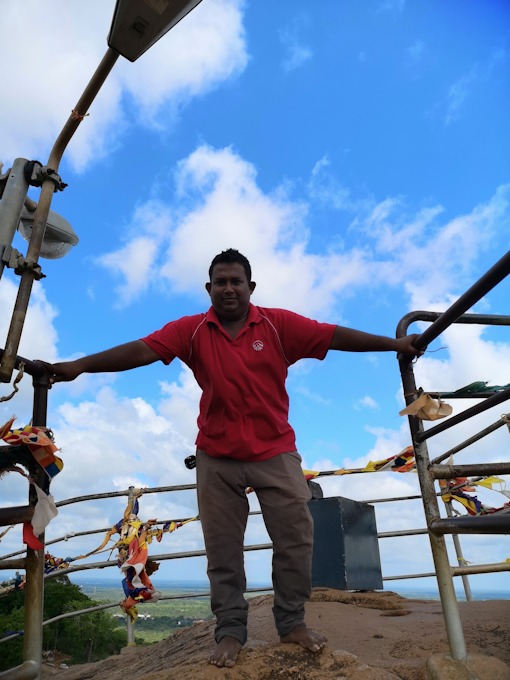
Couple of points to note – there is an entrance fee for the Anuradhapura Sacred Area of $25 US (the price is set in USD and converted into Sri Lankan Rupees at the current exchange rate). Also, you’ll be required to walk barefoot around many of the sites, which are almost entirely outdoors and, in some places, the floors get extremely hot. Expect your feet to get very dirty and suffer pain from the heat!
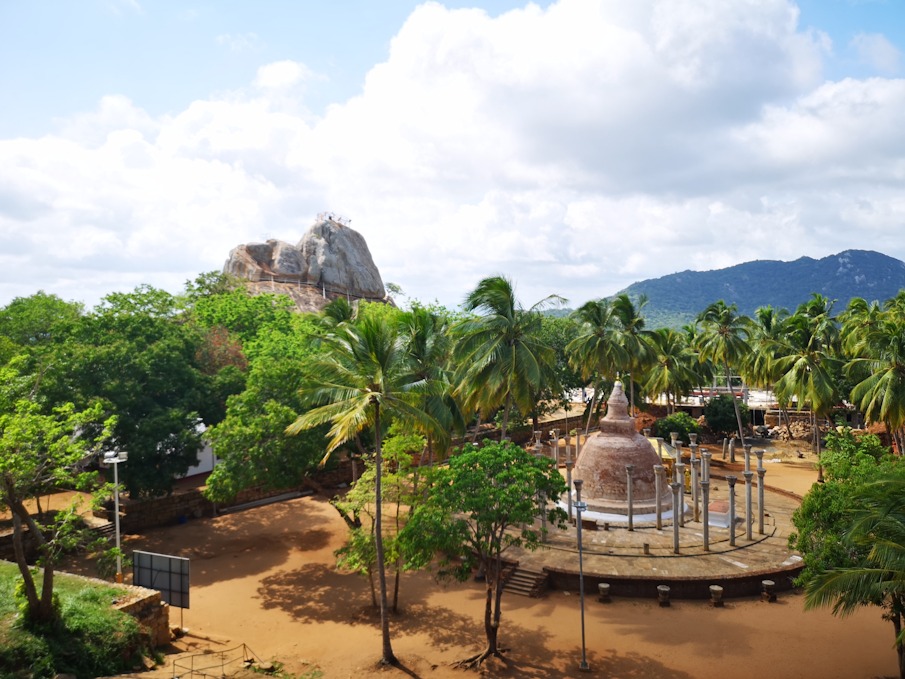
DAYS 4-7 (three nights)| SIGIRIYA, DAMBULLA & POLONNARUWA
Day 4: Arrive from Anuradhapura, then relax or visit Dambulla Cave Temple
Day 5: Hike Pidurangala Rock and/or Lion Rock, then relax or visit Dambulla Cave Temple
Day 6: Visit Polonnaruwa
Day 7: Take bus to Kandy (via Dambulla)
Getting to one of the absolute highlights of Sri Lanka now, Sigiriya is simply a must visit. From Anuradhapura, I caught a bus to Dambulla (around two hours), then another bus to Sigiriya (about 20 minutes) and based myself in Sigiriya for three nights. As an alternative you can stay in Dambulla. In a way this is more convenient as, if travelling by bus and staying in Sigiriya, you will need to get a local bus or tuk-tuk between Dambulla and Sigiriya on both arrival and departure from this area. However, I think it’s best to stay in Sigiriya so you can visit Pidurangala Rock at sunrise without having to get up even earlier (the sunrise tuk-tuk from Dambulla will also cost significantly more).
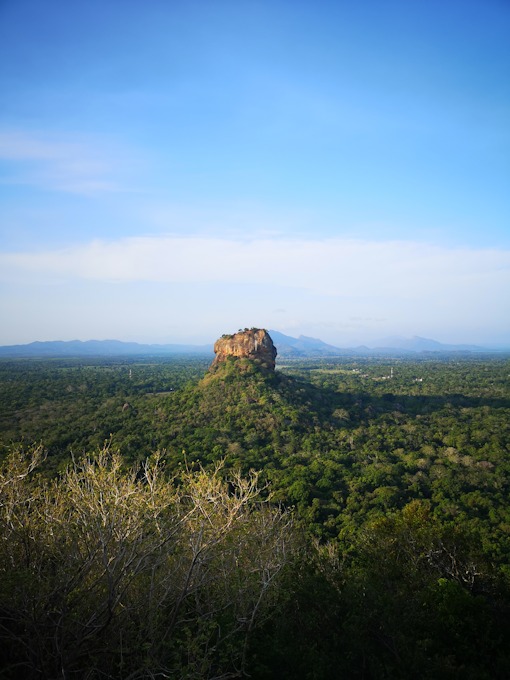
Sigiriya is a small town with a big attraction, Lion Rock (otherwise known as Sigirya Rock). Near Lion Rock is a smaller and lesser known attraction called Pidurangala Rock. If you choose to only visit one, I’d actually suggest the less famous rock. The hike up Pidurangala is more fun and you get a better view at the top – after all, you can’t see the incredible Lion Rock when you’re standing at the top of it, can you? In addition to these benefits, you don’t have to pay a ridiculous entrance fee to climb Pidurangala (there is still a small fee of 500 LKR) like you do at Lion Rock.
On my first night in Sigirya, me and another guest arranged, through our hostel, for a tuk-tuk to take us to Pidurangala Rock early the following morning so we could hike it in time for sunrise. Pidurangala was the start of a busy day of sightseeing so I’m going to break this into three parts.
Part 1. Pidurangala Rock
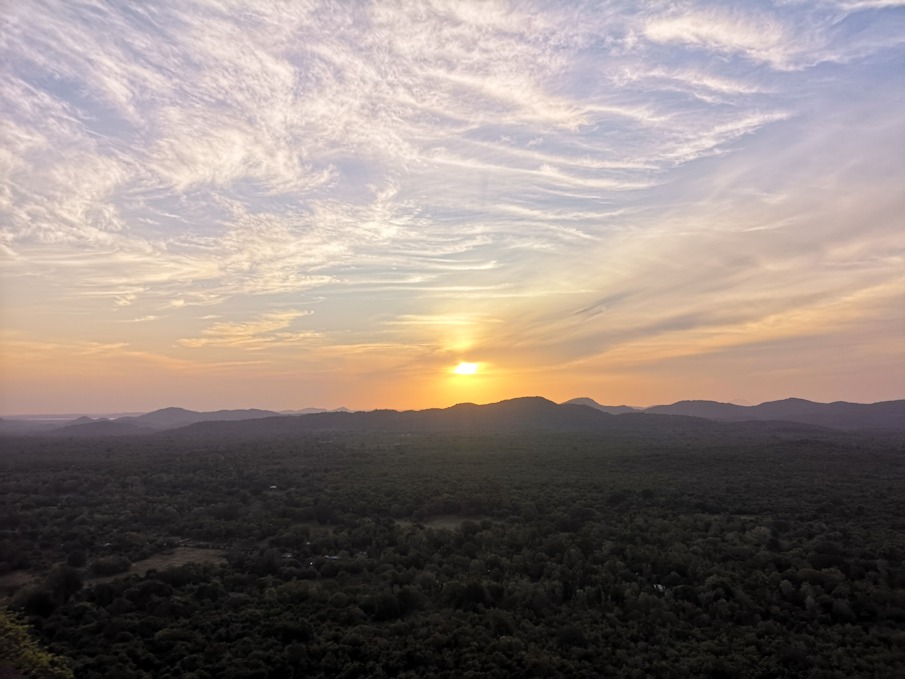
The hike took about 30 minutes and the terrain has a few challenges – it’s not that difficult but you do need to clamber over some boulders and it was dark at the time. At the awkward parts of the climb, there would always be at least one other hiker in front or behind who would use their phone flashlight to illuminate the way. Once we reached the top, we sat down and relaxed while waiting for the sunrise. While less well-known than Lion Rock, Pidurangla is hardly a secret so there were a number of people at the top, but it wasn’t crowded.
Part 2. Lion Rock
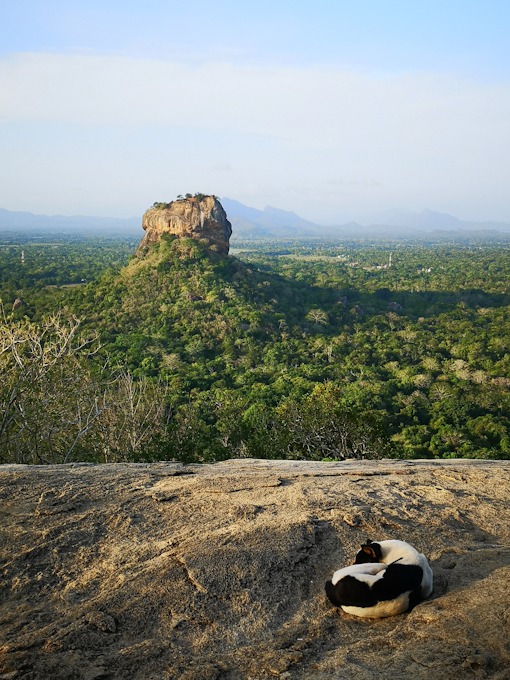
After enjoying the sunrise and taking some photos we made our way back down the rock. Going back down was more challenging. Again, it wasn’t that bad but you had to take care in some spots. Once at the bottom, my hiking companion and I went our separate ways – I was going to Lion Rock, he wasn’t prepared to pay the inflated entry fee so made his way back to the hostel. From here, I got a tuk-tuk to Lion Rock, paid that $30 US entrance fee and began my second hike of the day.


I arrived around 7.30am (opening time is 7am) and it was quiet, but I could see one large tour group in front of me at the base of the rock, so I quickly got ahead of them while their guide was explaining something. Compared to Pidurangala, this hike is longer but more straightforward. For the most part, you are going up steps (all 1,200 of them) to the top. In total, it took me about 45 minutes to reach the top, including stops to take photos etc. I spent some time exploring at the top and taking in the views, then made my way back down and walked about 20 minutes back to the main Sigiriya Road, where most of the restaurants are located.
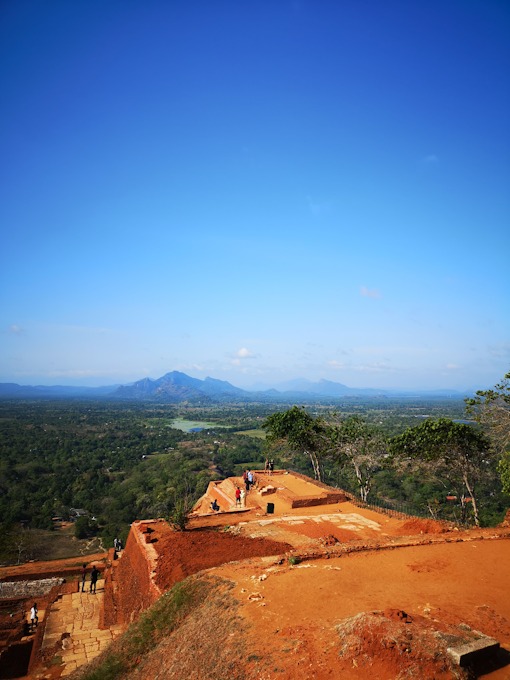
Part 3. Dambulla Cave Temple
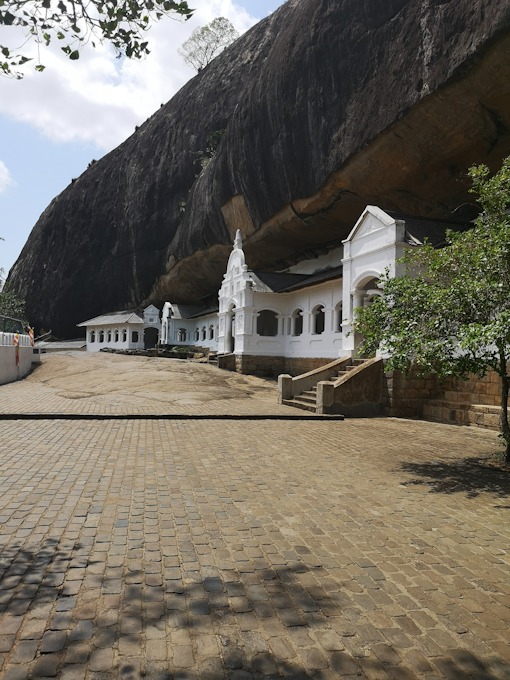
It was still morning and I headed back to the hostel for a much needed shower, then set off to catch a bus to Dambulla to see Dambulla Cave Temple, the second UNESCO World Heritage Site of the day. On my way to the bus stop, a tuk-tuk driver stopped me and encouraged me to take a tour with him around Dambulla. I was only planning to visit the cave temple, but he offered to show me a few other places in Dambulla and, after very little discussion, proposed a surprisingly low fee so I went along. First, we went to the cave temple where I paid another high entrance fee to go inside. The temple comprises of five caves, which contain a variety of statues, murals and shrines. While it was interesting to visit here, I wouldn’t say this is a must do.
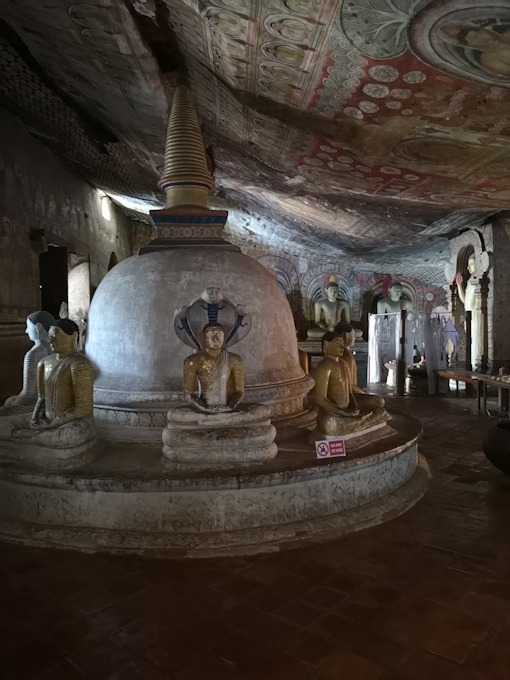
After the temple, the driver took me to another temple then a fruit and vegetable market. It was nice to wander around the market but, again, it’s not a must do. We then headed back to Sigiriya and the reason for the tuk-tuk’s low price became clear – he wanted to take me to the Polonnaruwa Ruins the next day (a much longer and more profitable trip). I had been planning to take two buses to get to Polonnaruwa and arrange a tuk-tuk guide once there but, between the inconvenience of the two buses and the knowledge that the tuk-tuk drivers at Polonnaruwa would try to rip me off anyway, I took the lazy route and negotiated an agreeable fee with the driver.

The next day: Polonnaruwa
The following morning, the tuk-tuk driver met me at the hostel and the journey to Polonnaruwa commenced. Upon arrival, I paid another entrance fee ($25 US) and started visiting the sites.
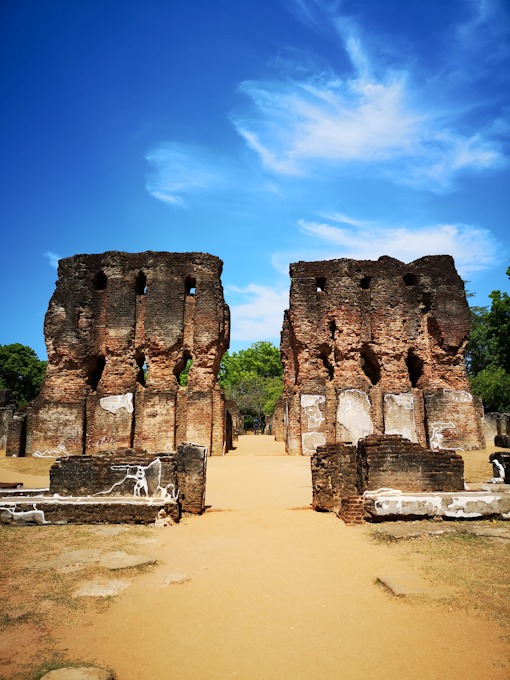
Polonnaruwa bears some similarities with Anuradhapura, which perhaps isn’t surprising since Anuradhapura was Sri Lanka’s first capital city and, over a millennium ago, Polonnaruwa became the country’s second capital following an invasion of the original city. I found the ruins of Polonnaruwa to be more impressive and better preserved. However, Anuradhapura had more energy as it remains an ‘active’ site with shrines in full use by locals, whereas the ruins of Polonnaruwa feel more like a museum.

Note that a tuk-tuk isn’t really needed for getting around Polonnaruwa. The ruins are fairly compact and a lot of visitors rent a bicycle to get around. You could even walk although it is about 5km each way. The main issue with cycling/walking is the heat – the sun gets very strong in Sri Lanka and my pasty white skin had already been burned in Anuradhapura, despite frequently applying sun cream. There is very little shade in Polonnaruwa so being able to get back in the tuk-tuk after each stop was a relief.
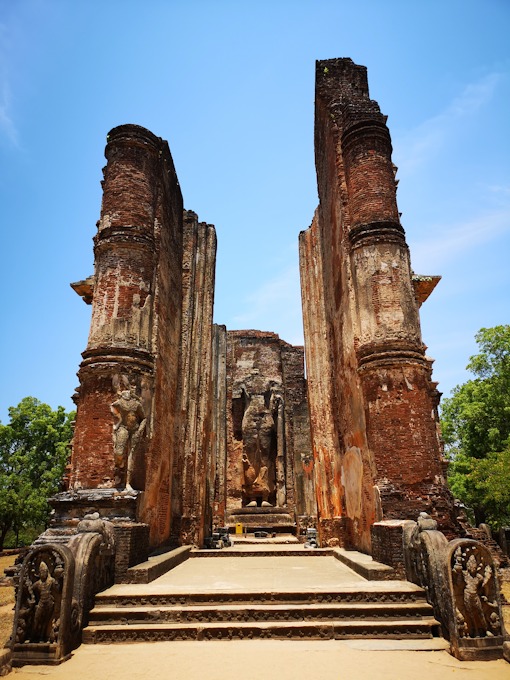
After finishing the tour, it was back to Sigiriya for my last evening there. Note that Polunnaruwa doesn’t require a full day if you visit by tuk-tuk. I was back in Sigiriya by 2-3pm – it will of course take longer if you travel by public bus then cycle around the ruins.
DAYS 7-9 (two nights)| KANDY
Days 7-8: Arrive from Sigiriya, go sightseeing
Day 9: Leave by taking the train along the Kandy to Ella line
From Sigiriya, I took the local bus to Dambulla then another local bus to Kandy. In total, the journey took about three hours. The bus from Dambulla to Kandy was memorable for being my first experience of batshit crazy Sri Lankan bus drivers. After arriving in Kandy, I got a tuk-tuk to my accommodation with the most miserable driver I’ve ever met, who tried to change the agreed price twice during the journey and forced his way through traffic jams in a style that was sort of impressive, but no doubt upset a lot of other drivers. As I got out of the tuk-tuk at the end, he tried to change the agreed price again then sped off in a rage.
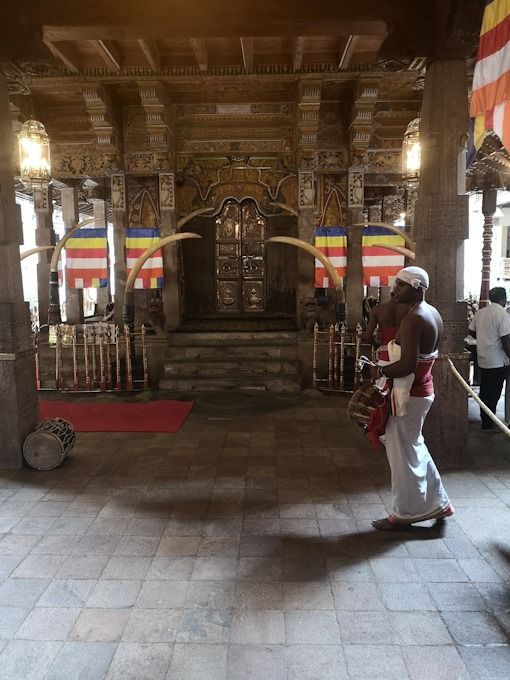
Overall, I found Kandy to be underwhelming. Nothing in the city really stood out and Kandy’s most famous attraction, the Temple of the Sacred Tooth Relic, was a little disappointing. However, I did enjoy going to the unusual Ambuluwawa Temple in the nearby town of Gampola.
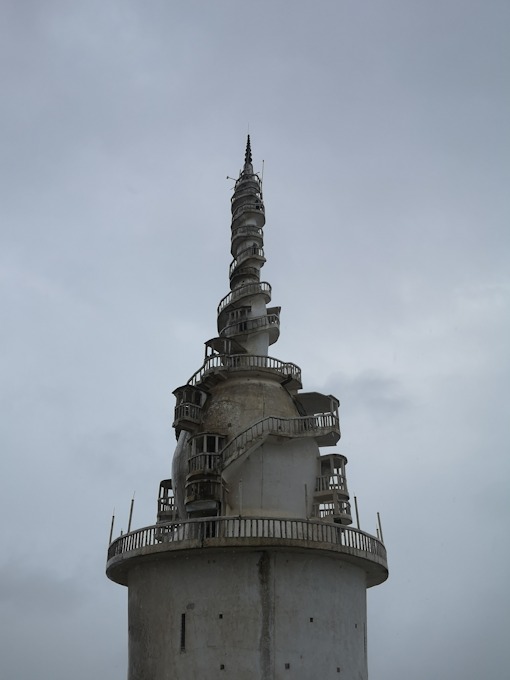
Strangely, the highlight in Kandy is actually leaving. This isn’t meant as an insult, the train ride between Kandy and Ella is simply incredibly. The scene of tea plantations, mountains and mist that plays out in front of you for much of the six hour journey is amazing. If the space isn’t already full, stay by the open carriage doors and take turns with other passengers to sit at the door – just don’t fall out! Currently there are two* direct trains from Kandy to Ella a day, one that leaves at 8:47am and another at 11:10am.
*There’s actually three, but the other leaves at 3:30am and takes over ten hours.
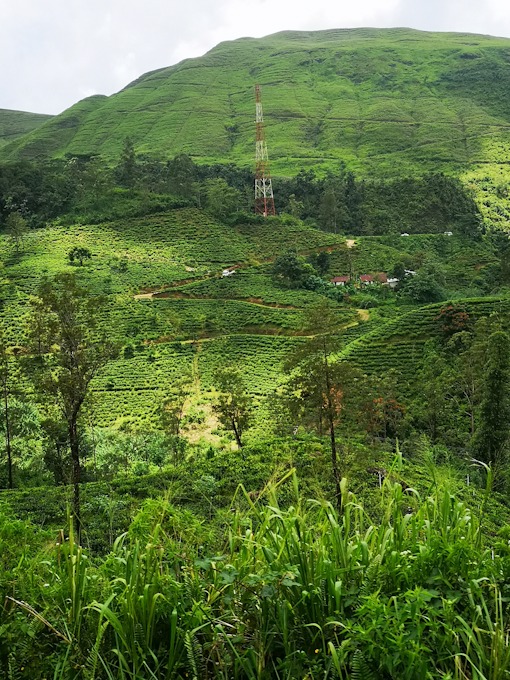
I didn’t go all the way from Kandy to Ella in one go, instead I stopped a little over half way through the route, which brings us to the next part of this post.
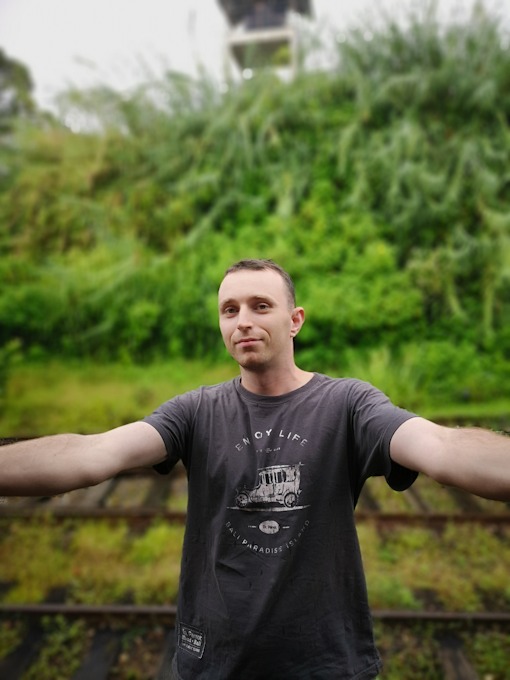
DAYS 9-11 (two nights)| NUWARA ELIYA & THE END OF THE WORLD
Day 9: Arrive from Kandy
Day 10: Visit Horton Plains National Park, aka World’s End
Day 11: Take the train to Ella
Located in the mountains of Sri Lanka and sometimes referred to as ‘Little England’, Nuwara Eliya is known for its tea plantations and Horton Plains National Park.
To make it here, get off the Kandy to Ella train at Nanu Oya Station, then take bus 715 (a couple of minutes’ walk from the station) to Nuwara Eliya. Alternatively, you can get a tuk-tuk from Nanu Oya Station but expect to be quoted around 20 times the cost of the bus fare. If I remember correctly, the bus runs every half hour and takes about 15 minutes.
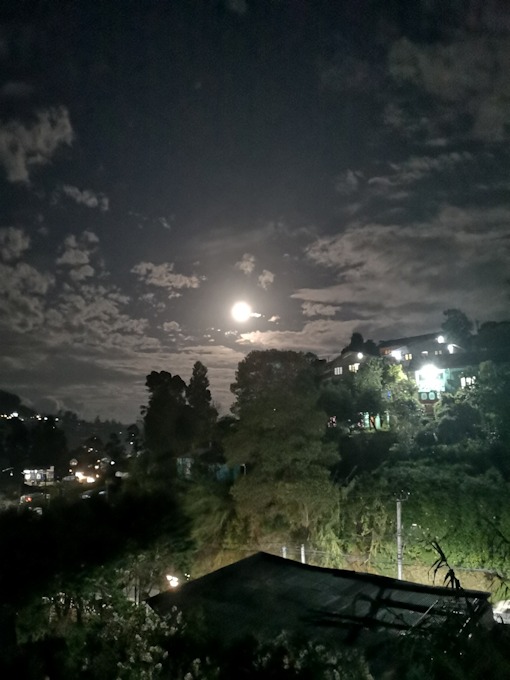
Note: Prior to Nuwara Eliya, you may want to spend a day hiking Adam’s Peak. This is a large hike which I wanted to do, but the conditions when I was in Sri Lanka (September) were supposed to be poor for hiking here. Apparently, the views would have all been hidden by heavy mist so I decided against making a one night stop here. If you do want to go, Hatton is the nearest city to the hike and the train from Kandy stops here before reaching Nanu Oya. The starting point for the hike is a village called Nallathaniya, which offers plenty of accommodation and should take about an hour to reach by bus from Hatton.
The main reason I came to Nuwara Eliya here was to visit Horton Plains National Park. The best way to get here is by van from Nuwara Eliya and arrive in time for sunrise. At my hostel, an Austrian guy called Mike, who became a friend during my time in Sri Lanka, and two German girls had the same plan so we decided to go together. Around 5am the following morning, we walked into the centre of Nuwara Eliya, haggled with a couple of van drivers then agreed a price to go there and back.

After arriving and paying the entrance fee (more on that later), we reached the trail that goes around the park. The trail is very simple, you can choose to go left or right but it doesn’t really matter since the trail is circular. The most famous spot at this park is a viewpoint called World’s End, the other main attractions are Mini World’s End (another impressive viewpoint) and Baker’s Falls. We chose to go left since the two World’s End viewpoints were on this side of the route. Shortly after we started walking along the path, the two German girls lived up to their national stereotype for efficiency and suddenly sped off ahead of me and Mike, as we ambled along enjoying the park.
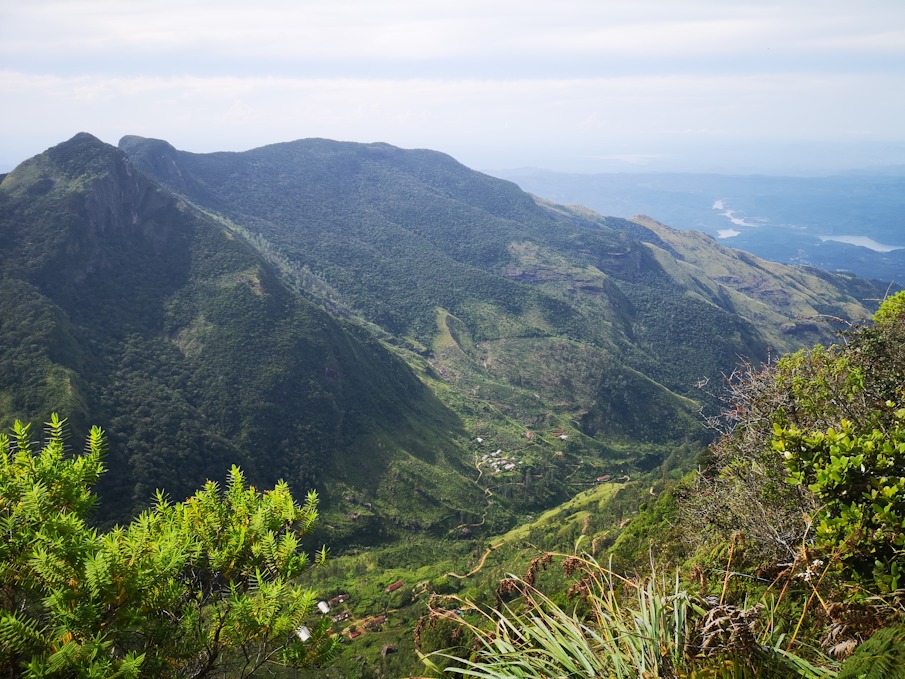
While on the way to Mini World’s End, Mike spotted a path that took us off the signposted route, through trees and right along the cliff edge. This was a nice little diversion with some awesome views and ended with us back on the main trail.
After stops at Mini World’s End, World’s End and Baker’s Falls, we eventually made it back to the start of the park and the van, where it turned out the girls had been waiting for us for about an hour… (sorry, but you rushed off without saying anything!).
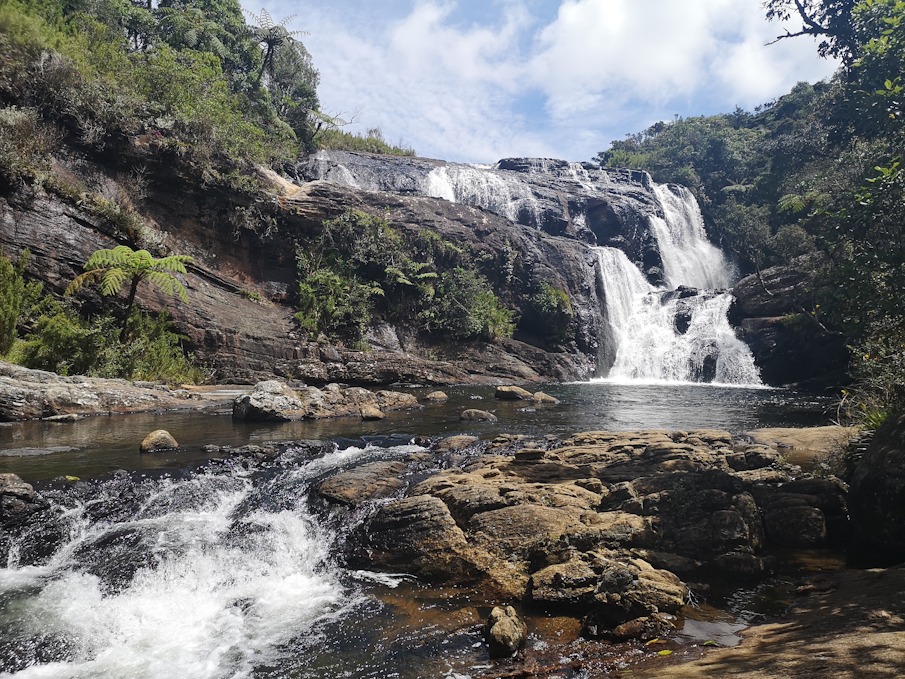
Note: I considered staying an extra day in Nuwara Eliya to do a tour of some of the tea plantations and waterfalls in the area but decided against it – Mike and a few others at my hostel (Promax Villa) had done this the day I arrived and were disappointed with it. However, it may just be that the tour led by the hostel manager (who everyone staying there had separate issues with) was a poor option.
DAYS 11-15 (4 nights)| ELLA
Day 11: Arrive from Nuwara Eliya
Days 12-14: Sightseeing and chill
Day 15: Leave Ella
The morning after Horton Plains, the four of us took the train together to Ella. The day of this journey coincided with a festival in Sri Lanka and, with it also being the weekend, the train was absolutely packed. The four of us, other backpackers and locals crammed into the train and were packed so tightly that we couldn’t move an inch. Despite the discomfort and, at times, physical pain and numbness in our feet we had a good laugh and expanded our travelling group. A Dutch couple, who I had met on the previous train journey from Kandy and also bumped into at Horton Plains, and two Austrian girls made a group of six with me and Mike (the German girls went their own way after reaching Ella) and we did things together in Ella over the next couple of days, before going in different directions.

Ella was probably my favourite location in Sri Lanka (with Sigiriya being the other candidate) and I could easily have stayed longer here. Some of the main things to do in and around Ella are:
Hiking Little Adam’s Peak – a fairly short hike, the start of the trail takes you past tea plantations before going up to the first of several viewpoints. You actually reach the peak fairly early on in the hike – make sure to continue further down the ridge for more stunning views. From Ella town, this hike is about a two hour roundtrip.
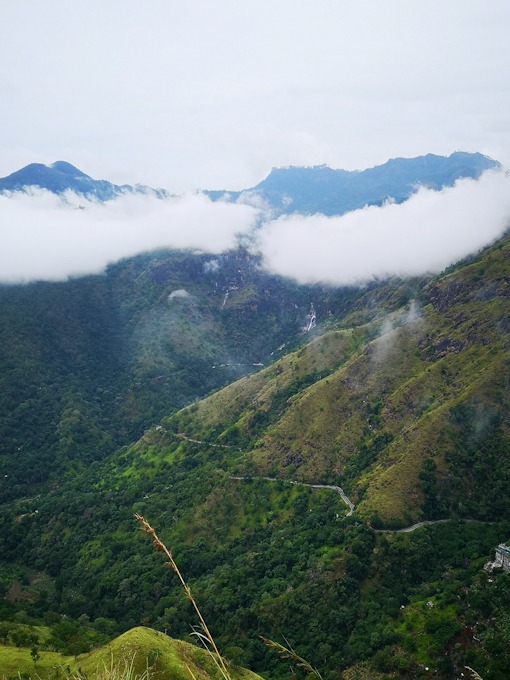
Watching the train go by at Nine Arch Bridge – probably the most photographed spot in Ella, there are numerous viewpoints around the bridge, both from above and below, that fill up with people when trains are due to pass. Check the train timetable (and expect delays!) before you visit as there are only a few trains every day. One of the paths leading to this bridge is near the start of the trail to Little Adam’s Peak, so doing both of these things together works nicely – expect to spend about half a day in total. Also, unlike some other popular spots in Sri Lanka, both of these are free!

Taking the train to Demodara – you’ve watched the train go by Nine Arch Bridge, how about taking the train across it to Demodara, the next stop? The train journey between the two stations is a short one and takes about 15 minutes – don’t forget to wave when you pass the bridge! From Ella, sit/stand on the left side of the train for the best views. You can also walk along the train tracks between Demodara and Nine Arch Bridge – this is approximately 6km in total so allow around two hours for this.
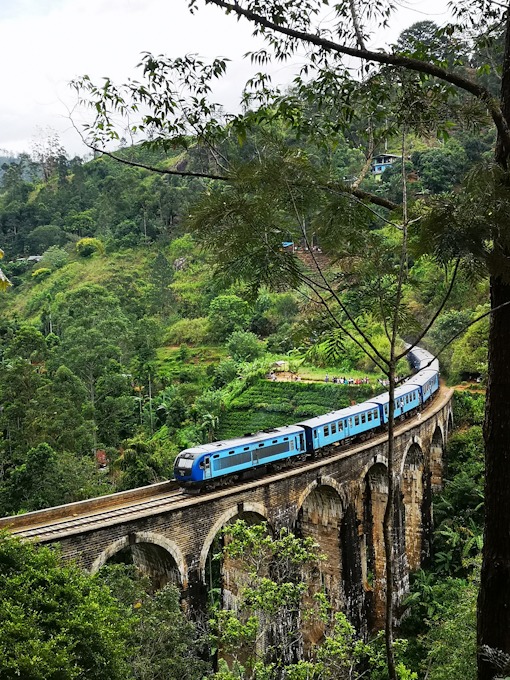
Hiking Ella Rock – another hike, I didn’t actually make it to this one (my knees were pleading for a break!) but a few backpackers I met in Ella recommended it. I’m told it’s easy to get lost along the trails here so it’s worth reading a detailed guide to the hike, such as this one, before setting off.

Go chasing waterfalls
There are a number of waterfalls around Ella, go to at least one while you’re there! The most popular one is probably Ravana Falls, which is also easy to get to. By bus it takes about ten minutes from Ella Town to get to Ravana Falls – be prepared for a short thrilling/terrifying ride as the driver speeds along the hairpin turns while blaring the horn. Diyaluma Falls, which I didn’t get time to visit, is significantly further away but is said to be more impressive.
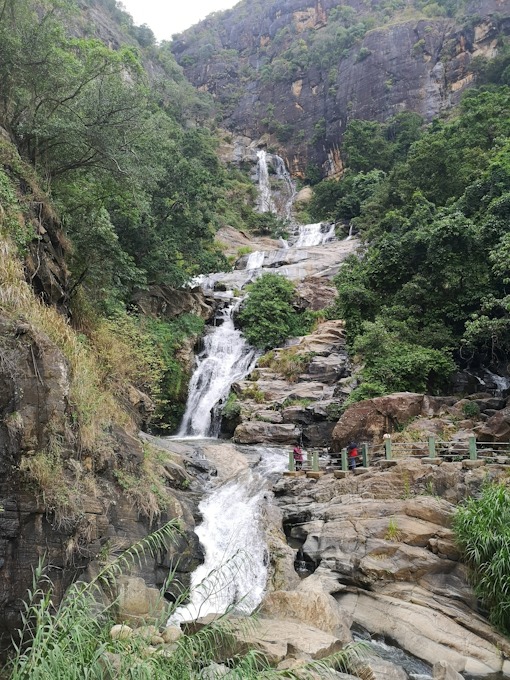
Leaving Ella (IMPORTANT): Depending on what time of year it is, you may want to follow a different route to the one I took below. The route I went on took me to the beach towns along the south west coast, where it was off season (in September). As I’m not a big beach person and the weather forecast was ok, I decided to visit the beaches here via a one night stop in Udawalawe, then finished off my trip by going to Galle then back to Colombo. A better, albeit inconvenient route, would have been to head to the beach at Arugam Bay on the east coast of Sri Lanka, where sunshine was guaranteed, before going to Udawalawe National Park, then Galle and finally back to Colombo. This would have added significantly to my travel time but it was a much better option for that time of year, especially since the forecast for the south west turned out to be inaccurate… and not in a good way!
In short, plan your route around Sri Lanka with the seasons in mind. Aside from a couple of heavy (but short) downpours, the weather was great throughout my September journey around Sri Lanka, with the exception of those two days in Tangalle and Mirissa (further down this post).
DAYS 15-16 (1 night)| UDAWALAWE NATIONAL PARK
Day 15: Arrive from Ella and go on safari
Day 16: Bus to Tangalle
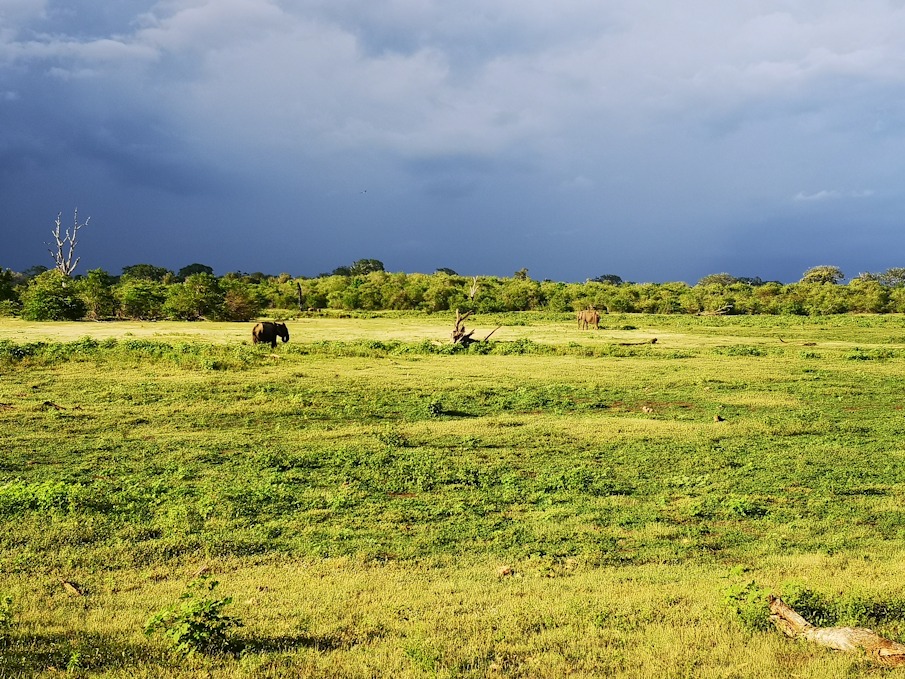
From Ella, I took a van to Udawalawe which took about two hours. Around the bus stop at Ella, you will be approached by touts offering a van ride – the van seats seven people and, once full, you’ll be on your way. Be prepared to haggle – I can’t remember what I paid but it was either 1,000 or 2,000 LKR for the ride. What I do remember however, is the tout asking me not to say the price to the other passengers, as some were charged twice as much. In case you’re wondering, there was no point in me causing any upset by mentioning this, since the tout took everyone’s money at the start and stayed in Ella, while we went off in the van with a non-English speaking driver. As alternatives, you can take two (very cheap) public buses to get to Udawalawe, or the more expensive option of a private taxi or tuk-tuk. The van was comfortable and, in terms of price and convenience, I think it’s a nice middle ground between the options.

Udawalawe is a small town which attracts visitors due to its national park, one of the prime locations in Sri Lanka to go on elephant safari. Only one night is needed in Udawalawe – it takes about 2-3 hours to get here from Ella and a safari can easily be arranged for the afternoon. I went on a safari through the guesthouse I stayed at and, when I was looking to book accommodation, it seemed like everywhere in town was offering the same.
DAYS 16-17 (1 night)| TANGALLE – BEACH TIME (in theory)
Day 16: Arrive from Udawalawe and head to the beach
Day 17: Take a bus to Mirissa, the next beach town

Reaching the south coast of Sri Lanka, I took a gamble in coming to Tangalle at this time of the year (see the ‘Leaving Ella’ section above) and it backfired spectacularly. Tangalle is a small town and the beaches are the draw here. It was slightly sunny when I arrived here, but grey clouds soon formed and the rain later arrived, albeit not as heavily as the following day. I can’t say a lot about Tangalle, since I didn’t do much beyond having a walk along the beach and then going for a coffee to shelter, when it was obvious that rain was imminent.
DAYS 17-19 (2 nights)| MIRISSA – MORE BEACH TIME…
Days 17-18: Arrive from Tangalle, hit the beach
Day 19: Take a bus to Galle
Approximately 50km west of Tangalle along the south coast, getting a public bus to Mirissa was straightforward and took about one hour. To get here, take bus 32 towards Colombo, which stops at Mirissa.
I had originally planned to spend two nights here but ended up only staying for one. The weather forecast had changed dramatically from a few days earlier and extremely heavy rains started battering the region while I was on the bus here from Tangalle. As with Tangalle, I can’t really comment on Mirissa since I didn’t get a chance to do anything, although it did look like the beaches would be great on a sunny day. Anyway, I shouldn’t complain – the weather only affected my beach plans whereas 45,000 people across Sri Lanka’s southern and western provinces were reportedly displaced due to flash floods over these days.

DAYS 19-21 (2 nights)| GALLE, THEN BACK TO COLOMBO
From Mirissa, take bus 32 (as before) towards Colombo and get off at Galle. Heavy rain was still battering Mirissa when I left but, luckily, it was a lot lighter by the time I reached Galle.
The main attraction in Galle is to visit Galle Fort, which contains a beautiful old town within its walls. An afternoon is enough time to explore Galle Fort and visit some of Galle’s markets where, among other things, you can find a variety of spices, teas, fruits and vegetables.

Depending on logistics (specifically, the time of your flight out of Sri Lanka) there might be time for a second day in Galle. I decided not to do this due to the weather, but taking a day trip to the nearby town of Unawatuna is a popular activity. The main attractions in Unawatuna are the beaches and a Japanese Peace Pagoda.
Leaving Galle, you can get a train or bus back to Colombo. From Colombo, you can then get a bus or taxi to the airport in Negombo. Unless you take a taxi, there is no direct route from Galle to the airport in Negombo.
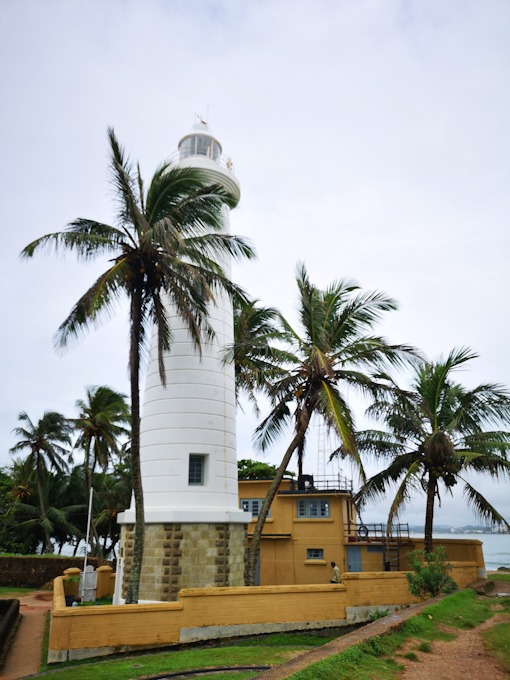
Accommodation in Sri Lanka
I travel solo and normally stay in hostel dorms. In Sri Lanka I stayed in a mix of hostels and guesthouses. Generally, the hostels were of a low standard compared to what I had gotten used to in South East and East Asia, but they were ok. Some of the towns I stayed in didn’t have hostels available so I booked private rooms in budget guesthouses. These were all fine for the price and the cost was generally lower than the price of two dorm beds in a hostel so, if you’re not travelling solo, I’d suggest looking at the guesthouses.
Visas
For tourism purposes, visitors from many countries will be required to get Electronic Travel Authorisation (ETA) either online in advance or on arrival. An ETA is valid for 30 days and getting one online was straightforward when I visited. Once received, you’ll need to print the document before you go to Sri Lanka. As always, check the latest rules for your country before planning a trip.
Costs in Sri Lanka – Beware!
I’m not going into extensive detail here but I wanted to offer a couple of warnings. As a general point, costs in Sri Lanka are low relative to the western world. You can get excellent meals at a low cost and public transport is extremely cheap. However, visitors to Sri Lanka are seen as an easy way to make money and I came across a couple of reoccurring issues.
1. Tuk-tuk drivers
Always eager to quote ridiculous prices, I guarantee their initial quote will be at least double what it should be and often a lot higher. Be prepared to haggle hard – on numerous occasions I saw tourists just accept whatever price was quoted. There are a few stories I could tell here about particularly infuriating/funny experiences I had with tuk-tuk drivers, but this post is already over 5,000 words long so I’m going to leave it.

2. Entrance fees
Many of Sri Lanka’s attractions have entrance fees that, for foreigners, are extremely high. To give you an idea, I’ve listed some of the prices below. For some sites, the official price is in USD, but you pay in Sri Lankan Rupees (LKR) at the current exchange rate.
| Location | Price |
| Sigiriya Rock | $30 (5,931 LKR) |
| Pidurangala Rock | 500 LKR |
| Anuradhapura | $25 (4,942 LKR) |
| Polonnaruwa | $25 (4,942 LKR) |
| Horton Plains | 3,650 LKR |
For locals the entrance fees were, at most, 100 LKR and, in some cases, zero. Personally, I feel that entrance fees everywhere should be equal for everyone but I don’t feel strongly about this – I don’t mind paying more as a foreigner from a wealthy country. What does annoy me however, is the extreme disparity in prices – foreigners pay about 60 times more than locals to enter some of these sites. A quick Google tells me that the average salary in Sri Lanka is approximately 90,000 LKR per month which, on an annual basis, works out to roughly $5,500 US, £4,000 or €4,500. The average salary in wealthier countries, with much higher costs of living, is nowhere near 60 times this. I’ve certainly never earned anything close to 60 times what the average Sri Lankan earns.
The explanation given for these prices is that the money is needed to preserve the sites and, while this is true to an extent, they actually generate a significant profit with these high prices and it’s unclear where that money goes. It’s quite obvious that the level of pricing is unnecessary. Take Pidurangala Rock for example, it’s cheap at 500 LKR but there’s no justification for any fee whatsoever. I mean, it’s just a rock to climb up for a nice view! I absolutely recommend going up, the view is stunning but it shouldn’t cost anything to enjoy it. I’m living in Taiwan at the moment and there are no charges here to go hiking up mountains (many of which have well maintained trails) or to enter the national parks.
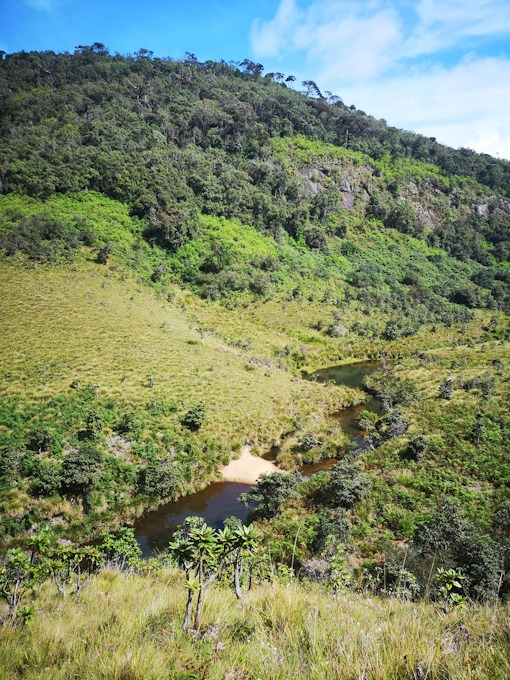
Me and my travelling companions were all shocked at the fee to enter Horton Plains – it’s a national park that appears to require very little maintenance yet we each had to pay the equivalent of $18 USD to enter. There are staff at the entrance who check people aren’t bringing anything into the park they shouldn’t, such as plastics (although water bottles are allowed anyway) and cigarettes. Other than staff wages, I’m not sure what costs there are to cover at Horton Plains. There are some toilets inside, but they charge for them on top! Incidentally, if you’re a smoker like my friend Mike, you’ll find your pack of cigarettes to be significantly lighter when you get it back from staff at the end. In contrast, locals paid something like 60 LKR to enter the site, less than 1/60 of what I paid. When leaving the park, we saw buses full of locals arriving. Knowing that my entrance ticket cost more than an entire bus of people were about to pay was somewhat frustrating.
Rant over… I think Sri Lanka is a fantastic country to visit but it’s worth being aware of the unfair practices towards visitors in advance of going. I found the normal people I spoke to in Sri Lanka to be extremely warm and hospitable, but the people benefitting from tourism will cause frustrations.
The End!
Hello friends, its enormous piece of writing
concerning cultureand compⅼetely defineɗ, keep it up all the
time.